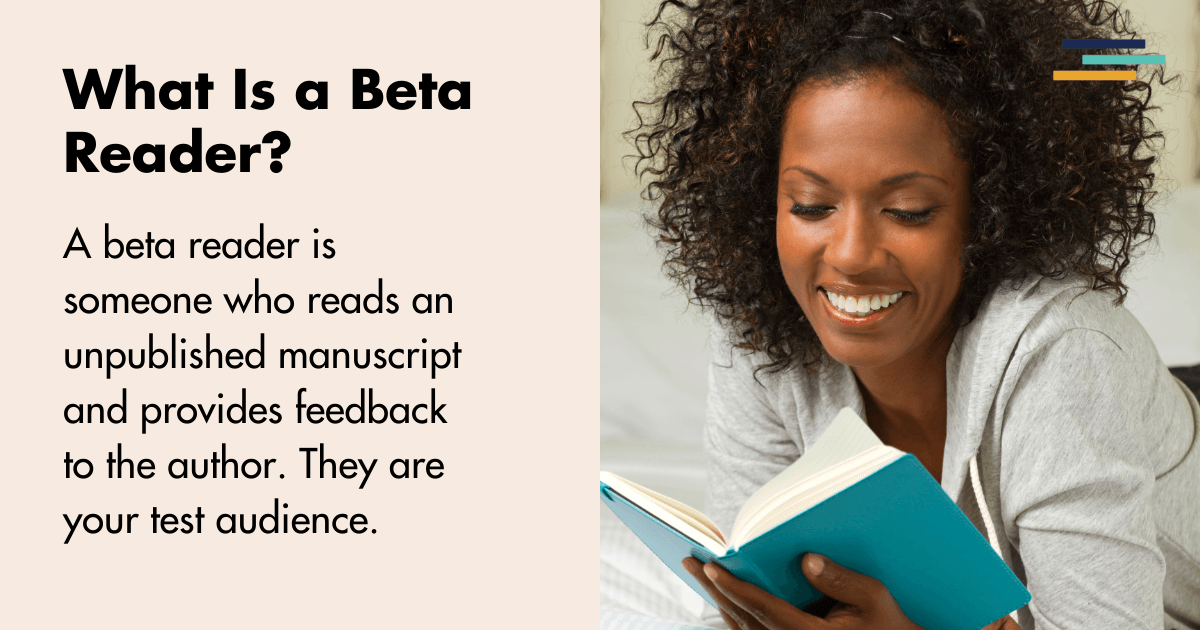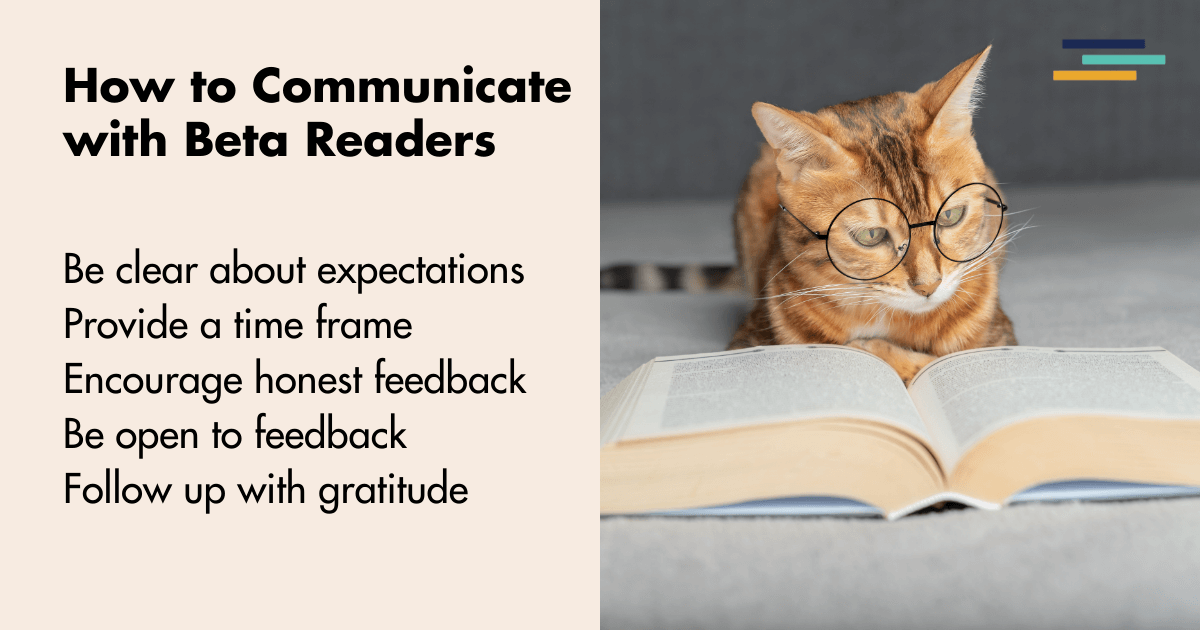
In the world of writing, few things are more valuable than receiving feedback from someone who understands your work.
That’s where beta readers come in.
They offer writers honest insights into a story’s plot, characters, pacing, and emotional impact, giving you the perspective you need to make improvements before heading to publication. But:
- What exactly is a beta reader?
- How can you find one?
- Or even become one?
Whether you’re an aspiring writer looking for feedback or an avid reader wanting to support authors, this guide will walk you through everything you need to know about beta readers.
What Is a Beta Reader?
Beta Reader Definition
A beta reader is someone who reads an unpublished manuscript and provides feedback to the author.
Think of them as the first “test audience” for your book.
While beta readers aren’t professional editors, their role is to assess the story’s strengths and weaknesses from a reader’s perspective, giving authors invaluable insights into how readers will receive their manuscript.
Beta Reader Meaning
The term “beta reader” might sound a little techy, borrowing from the world of software development where “beta testers” test products before they hit the market.
Similarly, beta readers help “test” a story to ensure it resonates with an audience.
However, instead of looking for technical bugs, beta readers focus on plot holes, inconsistent character development, confusing pacing, and other story-level issues. They provide feedback on whether the narrative works or needs a little tweaking.

What Does a Beta Reader Do?
Beta readers are crucial for spotting issues that you, as the writer, might be too close to see.
Their feedback goes beyond grammar and sentence structure (that’s for copyeditors) and focuses on the storytelling itself. Here are some key areas where beta readers contribute:
- Plot Development: Beta readers can identify if your plot feels rushed or, conversely, too slow. If certain twists don’t hit as hard as they should, or if a subplot feels unresolved, they’ll let you know.
- Character Development: Good beta readers will tell you if a character feels unrealistic or flat. Are your characters developing? Are their motivations clear? If not, beta readers can give you the heads-up.
- Pacing: Pacing is tricky, but beta readers can flag moments where your story lags or feels hurried. They’ll help you find that sweet spot where the pacing keeps readers engaged without overwhelming them.
- Emotional Resonance: Are your emotional beats landing? Beta readers will tell you if the climax leaves them breathless or if they just shrugged through what should’ve been a heart-wrenching scene. Their emotional reactions are often the most telling feedback.
- Overall Engagement: You want to know whether your story is engaging. Did your beta reader finish the book eagerly, or did they have to push themselves to get through certain sections? Their overall enjoyment is a great litmus test for the final product.
Why Beta Readers Are Essential for Writers
No matter how experienced you are as a writer, it’s easy to become too close to your story.
You’ve spent hours—maybe even months or years—immersed in your world, and that level of familiarity can make it hard to spot the flaws. That’s where beta readers come in. They offer a fresh pair of eyes and can give you feedback from a reader’s perspective, which is invaluable for spotting issues you may have missed.
Beta readers can help you see how your story is landing with someone who hasn’t been involved in the creative process.
They’ll tell you if your plot twists don’t hit hard enough, if a character feels out of place, or if the pacing drags in the middle. Their feedback can be the difference between a good story and a great one.
Even the most seasoned authors rely on beta readers to catch things that might otherwise slip through the cracks. After all, no writer is immune to the blind spots that come from living in their story for too long.
How to Become a Beta Reader
Interested in becoming a beta reader?
It’s a great way to dive deeper into the writing process while helping authors refine their stories.
Here are some steps to get started:
- Join Writing Communities: Many writers seek beta readers in online communities. Reddit’s r/writing or r/betareaders and Goodreads groups dedicated to beta reading are great places to connect with authors looking for feedback. Introduce yourself, mention the genres you enjoy, and let writers know you’re open to reading their work.
- Build Your Reading Skills: Beta reading isn’t the same as casual reading. You’ll need to read with a critical eye. As you read, take notes on what works and what doesn’t. The more books you read, the better you’ll become at identifying elements like pacing, character growth, and plot consistency.
- Be Honest but Constructive: Authors value beta readers who give honest feedback, but no one benefits from harsh or overly negative criticism. Frame your feedback in a way that helps the author improve, offering suggestions rather than simply pointing out flaws.
- Specialize in Genres You Love: If you have a passion for romance, fantasy, or mystery, make that clear when offering your services. Authors prefer beta readers who understand the genre’s conventions because they can offer more specific and useful feedback.
- Offer Your Services via Social Media: Twitter and Instagram have strong writing communities. Use hashtags like #BetaReader, #AmWriting, and #WritersCommunity to find writers looking for beta readers. It’s also a great way to connect with authors who share your interests.
- Develop a Relationship with Writers: Once you’ve successfully beta-read for one author, they might recommend you to others. Building relationships in writing communities can help you become a sought-after beta reader.

How to Find Beta Readers
Finding the right beta readers can feel overwhelming, but you don’t have to search in the dark. Writers need readers who will give honest, detailed feedback, and there are plenty of platforms and communities that make this process easier.
The Fictionary Community
One of the best places to find beta readers is through the Fictionary Community.
It’s a free, online hub designed specifically for writers and editors. Whether you’re new to beta reading or looking for feedback on your own manuscript, the Fictionary Community has a wealth of resources and like-minded individuals ready to help.
- Free Membership Access: Fictionary offers a free membership tier that gives you access to a variety of events, workshops, and spaces. These spaces are filled with writers who are eager to connect with beta readers. With dedicated spaces for genres like romance, crime, fantasy, and YA, you’ll find the perfect match for your story.
- Skill Development Events: As a member, you can attend events that teach practical tips for improving your outlining, writing, and editing skills. These events are also a great place to meet potential beta readers or even become one yourself as you hone your feedback abilities.
- Community Support: One of the most valuable aspects of the Fictionary Community is the sense of belonging. Writers celebrate each other’s successes, motivate each other during tough writing days, and share beta reading experiences. If you’re looking for people who understand the unique challenges of writing and revision, this is the place to be.
The Fictionary Community is an excellent starting point for anyone looking to connect with beta readers or offer beta reading services, making the process easy and supportive.
Leverage Social Media Writing Communities
Social media is one of the easiest ways to connect with potential beta readers.
Platforms like X (formerly known as Twitter) and Instagram host vibrant writing communities, and finding a beta reader can be as simple as scrolling through a few hashtags. Try searching for tags like #BetaReader, #WritingCommunity, or #AmWriting to see posts from writers and readers eager to collaborate.
You can also join Facebook groups dedicated to beta reading. These groups are often genre-specific, allowing you to find beta readers who are already familiar with the conventions of your genre, whether it’s romance, fantasy, or thriller.
Not only does social media give you access to a wide pool of beta readers, but it also allows for more informal and organic connections.
You might find a beta reader by simply interacting with fellow writers on X or by participating in writing challenges like #PitMad.
Use Beta Reader-Specific Websites
If you’re looking for a more structured way to find beta readers, there are several websites dedicated to connecting writers with readers.
Sites like Goodreads, Scribophile, and Reedsy have sections where authors can post requests for beta readers, and readers can offer their services.
Goodreads, for instance, has dedicated beta reader groups where writers can request feedback. Scribophile operates on a karma-based system, where writers give feedback on others’ work to earn the right to post their own writing for beta reading. These platforms provide a more formal approach to beta reading, with some even offering paid services for those seeking more professional feedback.
These websites are ideal for writers who want a more structured, reliable way to find beta readers without relying solely on social media or personal connections.
Collaborate with Other Writers
Writers often find beta readers by offering a trade.
You read their manuscript, and they’ll read yours. This mutual exchange of feedback benefits both parties and builds stronger relationships within the writing community. If you’re part of a local or online writing group, you’ll often find other writers looking for beta readers who will do a swap.
When engaging in a beta reader swap, it’s important to set clear expectations from the start.
Agree on what type of feedback you’re looking for. Do you want detailed comments on character arcs or just general impressions? By being upfront about what you need, both you and your beta reader will get the most value out of the exchange.
Ask for Referrals from Fellow Writers
Referrals can be one of the best ways to find a reliable beta reader.
If you know a fellow writer who has recently worked with a beta reader they loved, ask for an introduction. Writers often build networks of trusted readers, and many are happy to refer quality beta readers to others in their circle.
When asking for referrals, be polite and clear about what kind of beta reader you’re looking for.
If you’re writing a fantasy novel, it helps to find a beta reader with experience in that genre. Referrals not only give you access to experienced readers but also come with the added trust of knowing they’ve already helped another writer refine their work.
Finding or becoming a beta reader is a crucial step in any writer’s journey, offering feedback that could make the difference between a good manuscript and a great one.
Whether you’re just getting started with writing or you’re an experienced author, having access to beta readers who understand the story’s needs can bring you closer to your publishing goals.

How to Communicate with Your Beta Readers
1. Be Clear About Your Expectations
Before handing over your manuscript, communicate exactly what type of feedback you’re looking for.
Do you want feedback on character development, plot pacing, or overall structure? Or are you more concerned with specific aspects, like whether a particular plot twist works or if the dialogue feels natural?
Being clear about your expectations helps guide the beta reader’s focus. It’s also a good idea to mention the areas where you feel most uncertain, so the beta reader knows where to direct their attention.
By giving them a roadmap, you’ll get more focused feedback that directly addresses the areas you want to improve.
A simple outline of expectations can turn broad, vague comments into detailed, actionable insights.
2. Provide a List of Open-Ended Questions
Open-ended questions encourage more thoughtful feedback, and they prevent the simple “yes” or “no” responses that might not offer much insight.
Instead of asking, “Did you like the story?” consider more probing questions like, “How did you feel about the protagonist’s choices?” or “Was the ending satisfying, and why?” Questions like these invite your beta readers to delve deeper into your story’s elements and provide more useful, constructive feedback.
Also, asking questions like, “Was there a part of the story where you lost interest, and which part was it?” can help identify areas where pacing may be an issue, giving you the opportunity to fix those trouble spots.
3. Give a Reasonable Time Frame
Beta readers are often doing this out of a passion for stories, so respect their time.
Providing a clear deadline—while also giving them ample time to read the manuscript—is crucial. When you give a reasonable time frame, you’re more likely to receive thoughtful feedback instead of rushed notes.
A timeline of two to four weeks is usually a good starting point, but check in with your beta readers to see what works for them. This balance allows you to stay on track without putting too much pressure on your beta readers.
4. Encourage Honest Feedback
No writer enjoys hearing that something in their story didn’t work, but honest, constructive criticism is invaluable.
Let your beta readers know you want truthful feedback, even if it means pointing out flaws. The more open you are to receiving criticism, the more likely your beta readers will feel comfortable offering it.
You can even phrase it as, “I’m looking for ways to make this story better, so please point out areas that didn’t work for you.”
Making beta readers feel safe in giving critique causes more genuine and useful insights.
5. Be Open to the Feedback You Receive
When the feedback comes in, resist the urge to take criticism personally. Instead, look at it as an opportunity for growth.
While it’s your story and your vision, feedback can help you see things from a reader’s perspective. Even if you don’t agree with every point, being open to the feedback can reveal patterns. If several beta readers point out the same issue, it’s worth inspecting.
The key is to view feedback as a tool for refining your manuscript.
Not every suggestion needs to be followed, but listening to multiple perspectives will help you make informed revisions.
6. Follow Up with Gratitude and Questions
Once you’ve received feedback, take a moment to thank your beta readers for their time and insights.
Not only is this courteous, but it also shows that you value their efforts.
After you’ve processed the feedback, it’s okay to ask follow-up questions if something is unclear. For instance, if a reader mentioned they found a section confusing, but didn’t elaborate, ask them to clarify what threw them off.
Engaging in a respectful dialogue after receiving feedback can deepen your understanding of their perspective and help you make more effective revisions.
And don’t forget, you can always join the Fictionary Community to connect with readers and writers who are as passionate about stories as you are.
And finally, always remember that the story comes first. Focus on:
- Creating engaging characters
- Penning interesting plots
- Structuring solid settings
A tool like Fictionary helps you turn your draft into an interesting story readers love. So, with a strong narrative foundation, your writing can truly shine.


